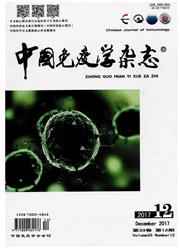

 中文摘要:
中文摘要:
目的:以中国北方汉族人群为研究对象,探讨中性粒细胞集落刺激因子(Granulocyte colony—stimulating factor gene,G-CSF,Csf3)基因多态性与系统性红斑狼疮(Systemic lupus erythematosus,SLE)和狼疮性肾炎(Lupus nephritis,LN)的相关性。方法:采用聚合酶链式反应-单链构象多态性(Polymerase chain reaction—single strand conformation polymorphism,PCR-SSCP)方法比较Csf3基因-1931位点单核苷酸多态性(Single nucleotide polymorphism,SNP)在正常人和SLE/LN病人中的分布。结果:SLE病人中A/G杂合子(60.5%)和等位基因A的频率(53.5%)明显高于正常对照组(51.6%,45.2%;P值分别为小于0.05和0.01):而G/G纯合子(16.2%)和等位基因G的频率(46.5%)明显低于正常对照组(28.9%,54.8%,P值均小于0.01)。Csf3基因-1931位点A/G型在SLE伴有蛋白尿和伴有血尿病人中的频率明显高于对照组,差别具有统计学意义。结论:Csf3基因不仅与中国北方汉族人群SLE的易感性相关,而且与中国北方汉族人群SLE患者的临床症状蛋白尿和血尿的易感性相关。
 英文摘要:
英文摘要:
Objective:To analyze the polymorphism(s) or mutation( s) in the granulocyte colony-stimulating factor gone (G-CSF, Csf3) and its possible assoeiation with the. susceptibility to systemic lupus erythematosus (SLE) and lupus nephritis (LN). Methods: Polymorphism screening of Csf3 was carried out by the polymerase chain reaction-single strand conformation polymorphism method( PCR-SSCP), using genomic DNA from 215 patients with SLE and the control of 459 ethnically matched healthy individuals in Northern Chinese. Results: A polymorqhism at position 1931 was identified. The frequency of A/G genotype(60.5 % ) and A allele(53.5 % ) at position 1931 in the patients with SLE were significantly higher than in the healthy controls(51.6 % and 45.2 %, P values less than 0.05 or 0.01, respectively), whereas the frequency of G/G genotype( 16.2 % ) and G allele(46.5 % )in the patients with SLE were lower than those in healthy controls (28.9 % and 54.8 %, P values less than 0.01 .The frequency of genotype A/G was much higher in SLE with pmteinuria(67.1% ) and with haematuria(71.2% ) than in SLE without proteinuria (46.4 %, P 〈 0. 005 ) and without haematuria ( 54.4 %, P 〈 0.05 ). Conclusion: The results suggest that Csf3 ( 1931 ) be significantly associated with the susceptibility to SLE/LN in Northern Chinese patients. Further studies on population distribution and functions will be followed to verify Csf3( 1931 ) as one of the susceptibility genes to SLE.
 同期刊论文项目
同期刊论文项目
 同项目期刊论文
同项目期刊论文
 期刊信息
期刊信息
